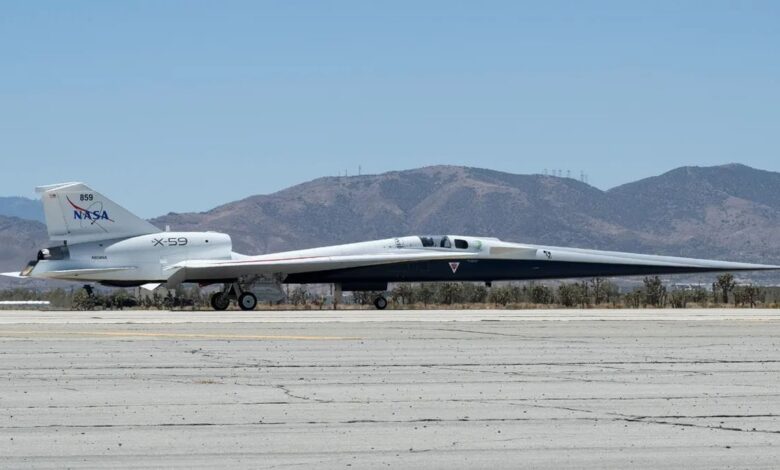NASA X-59: Closer to Supersonic Flight

NASA’s X-59: Paving the Way for Quiet Supersonic Flight
NASA’s X-59 QueSST (Quiet Supersonic Transport) is making significant strides toward its first flight, promising a future where supersonic air travel is no longer synonymous with disruptive sonic booms. This innovative aircraft, designed from the ground up, aims to break the sound barrier without the thunderous noise typically associated with supersonic flight. The recent advanced taxi tests and augmented vision system showcase the cutting-edge technology driving this project forward.
The X-59’s Unique Design: A Sonic Boom Silencer
The X-59’s most striking feature is its elongated, aerodynamic design. This unconventional shape is crucial for minimizing the sonic boom effect. Unlike traditional supersonic aircraft that create a sharp, loud boom, the X-59 is engineered to produce a much quieter “sonic thump.” This is achieved by carefully controlling the way the aircraft’s shockwaves propagate through the atmosphere.
- No Front Windscreen: One of the most notable design choices is the absence of a traditional front windscreen. Instead, pilots rely on the External Vision System (XVS), an augmented reality-enabled closed-circuit camera system. This system provides pilots with a clear view of the forward path, even without a direct line of sight.
- External Vision System (XVS): The XVS is a critical component of the X-59. It uses advanced cameras and display technology to create a virtual cockpit view, overlaying essential flight information onto the pilot’s display. This system not only compensates for the lack of a windscreen but also enhances situational awareness and safety.
Advanced Taxi Tests: Preparing for Takeoff
Before its first flight, the X-59 undergoes rigorous testing, including advanced taxi tests. These tests evaluate the aircraft’s ground handling characteristics, steering, braking systems, and overall performance. Conducted at the U.S. Air Force’s Plant 42 facility in Palmdale, California, these tests are a crucial step in ensuring the X-59’s readiness for flight.
Low-Speed Taxi Tests
During initial low-speed taxi tests, test pilot Nils Larson carefully maneuvered the X-59 along the runway. These tests focused on verifying the functionality of the steering and braking systems, ensuring precise control at lower speeds.
High-Speed Taxi Tests
Following the low-speed tests, the X-59 will undergo high-speed taxi tests. These tests involve accelerating the aircraft to near-takeoff speeds, allowing engineers to assess its stability and handling characteristics under more demanding conditions. Data collected during these tests will be used to fine-tune the aircraft’s control systems and prepare it for its first flight.
Plant 42: A Hub for Aviation Innovation
The U.S. Air Force’s Plant 42 facility in Palmdale, California, plays a vital role in the development and testing of advanced aircraft. Contractors and the Air Force utilize the plant for manufacturing and testing various aircraft. Lockheed Martin’s Skunk Works, responsible for developing the X-59, is also located at Plant 42, further solidifying its position as a hub for aviation innovation.
| Aircraft | Description |
|---|---|
| B-2 Spirit | Stealth bomber |
| F-22 Raptor | Advanced fighter jet |
| RQ-170 Sentinel spy drone | Uncrewed reconnaissance aircraft |
| SOFIA Airborne Observatory | A flying telescope (recently retired) |
Collaboration and Future Implications
NASA’s X-59 project is a collaborative effort involving various organizations, including Lockheed Martin and the Japan Aerospace Exploration Agency (JAXA). JAXA collaborated with NASA to test a scale model of the X-59 in a supersonic wind tunnel to measure the noise created under the aircraft. The data gathered will be crucial in refining the X-59’s design and minimizing its sonic boom signature.
The X-59 has the potential to revolutionize air travel by paving the way for quiet supersonic flight over land. This could significantly reduce travel times and open up new possibilities for both commercial and private aviation. By demonstrating the feasibility of quiet supersonic flight, the X-59 is poised to transform the future of air travel.




